NR SA NTN (Non Terrestrial Network)
This tutorial is to show you how to configure and test NR NTN. NTN (Non Terrestrial Network) is a type of network deployment in which some type of non-terrestrial (e.g, satellite or other airborne component). Overall protocol sequence of NTN is not much different from the existing NR RAN access (LTE NB, LTE, NR), but one major difference is to handle the long propagation delay between the ground components (eNB and/or DUT) and Satellite. There are one major components introduced in 3GPP NR NTN as listed below.
- Additional SIBs : This is mainly to inform the position of Satellite (i.e, ephemeris) and default time delay. In LTE case, the SIB19 carries these information.
There are various different type of NTN deployment in 3GPP TR 38.821. Currently Amarisoft NTN implementation is as shown below.
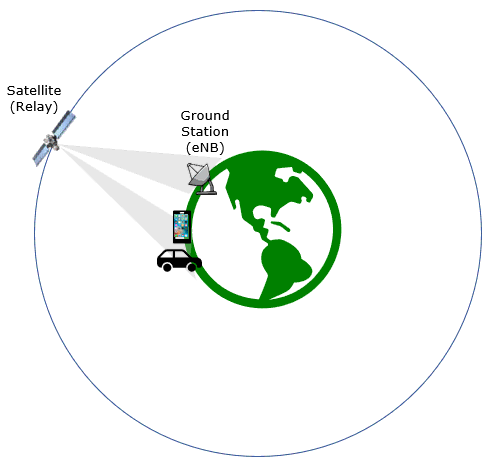
Table of Contents
- NR SA NTN (Non Terrestrial Network)
- Introduction
- Summary of the Tutorial
- Test Setup
- Key Configuration Parameters
- Before You Start : Time Synchronization
- Test 1 : NTN with Simulated GEO and UEsim
- Test 2 : NTN with LEO
- With generated satellite and embedded simulator
- With a 3rd party external simulator or a real satellite
- Test 3 : NTN to TN Handover
- RRC / NAS Signaling
- FAQ
Introduction
The emergence of Non-Terrestrial Networks (NTN) within the 3GPP New Radio (NR) framework represents a significant advancement in wireless communication, enabling seamless connectivity in environments traditionally underserved by terrestrial infrastructure. NTN leverages non-terrestrial platforms such as satellites or airborne vehicles to extend the reach of 5G NR services to remote, rural, oceanic, and disaster-struck areas where ground-based networks may be impractical or economically unfeasible. Architecturally, NR NTN is designed to integrate with the existing NR Radio Access Network (RAN), preserving core protocol sequences while addressing unique challenges posed by the satellite or aerial link—most notably, the considerable propagation delays between terrestrial entities (e.g., gNB or Device Under Test) and their non-terrestrial counterparts. To accommodate these challenges, 3GPP has introduced enhancements such as additional System Information Blocks (SIBs), specifically tailored to deliver satellite-specific parameters like ephemeris data and default time delay, ensuring robust network synchronization and performance. The implementation of NR NTN, as detailed in 3GPP TR 38.821 and realized in platforms such as Amarisoft, empowers network operators and researchers to evaluate end-to-end NTN scenarios, test protocol adaptations, and validate service reliability under the unique conditions of non-terrestrial environments. This tutorial provides a practical guide to configuring and testing NR NTN deployments, equipping learners with the foundational knowledge and procedural steps necessary to navigate this innovative domain of modern wireless systems.
-
Context of NR NTN Technology
- NR NTN extends 5G NR connectivity via non-terrestrial nodes (satellites, airborne platforms).
- Integrates with existing NR RAN architecture, sharing many protocol workflows with terrestrial NR/LTE systems.
- Addresses unique challenges such as high propagation delay and satellite-specific signaling requirements.
-
Relevance and Importance of the Tutorial Topic
- Enables connectivity for geographically isolated or infrastructure-deficient regions.
- Supports critical communications for maritime, aeronautical, and emergency response scenarios.
- Facilitates testing and validation of protocol adaptations required for NTN environments.
- Aligns with current industry and research trends towards universal, resilient 5G coverage.
-
Learning Outcomes
- Understand NR NTN architecture and key protocol enhancements introduced by 3GPP.
- Gain hands-on experience with the configuration and operation of NR NTN testbeds (e.g., Amarisoft implementation).
- Develop the ability to analyze and troubleshoot NTN-specific issues such as timing, synchronization, and signaling.
- Acquire insights into deployment options and system information management for NR NTN scenarios.
-
Prerequisite Knowledge and Skills
- Familiarity with 3GPP NR (5G) and LTE system concepts and protocol layers.
- Basic understanding of wireless network architecture and radio access procedures.
- Experience with network configuration, protocol analysis, and diagnostic tools.
- Awareness of Amarisoft or similar 5G NR test platforms is beneficial but not strictly required.
Summary of the Tutorial
This tutorial describes procedures for low layer testing of NTN (Non-Terrestrial Networks) using Amarisoft eNB and UEsim. It covers two main tests: one with a simulated GEO satellite and another with LEO, focusing on configuration, execution, and troubleshooting steps.
-
Test Setup Overview
- Utilizes Amarisoft eNB (Callbox) and UEsim for low layer tests.
- SIM card is used as delivered; configuration changes can be referenced from the Configuration Guide.
- Two setups are possible depending on test objectives.
-
Key Configuration Parameters
- Extensive configuration parameters are available for NTN, including satellite orbit settings, channel simulation, timing/frequency adjustments, and position parameters for satellite, ground station, and UE.
- Important parameters: ntn, sv_filename, default_ephemeris, ephemeris group, ground_position, ue_position, channel_sim_control, large_freq_shift, and others related to timing advance and Doppler compensation.
-
Test 1: NTN with Simulated GEO and UEsim
-
Configuration Steps
- Use gnb-sa-ntn.cfg on the Callbox/gNB as the base configuration.
- Select NTN_MODE as GEO. Configure parameters such as CSI_SRS_PERIOD, MAX_HARQ, T3XX_TIMER, SRB_T_POLL_RETX according to the selected mode.
- Enable CHANNEL_SIM (set to 'awgn' for this test) to simulate the radio link.
- Adjust ssb_period based on orbit type (set to 20 for GEO).
- Enable sib19 for broadcasting NTN-related information.
- Configure MAC timers (retx_bsr_timer, sr_prohibit_timer, prohibit_phr_timer, sr_trans_max) and RRC timers (t300, t301, t319, t_PollRetransmit) according to orbit RTT.
- Set ntn parameter to define positions for satellite (default_ephemeris), ground station (ground_position), and UE (ue_position).
- On UEsim, enable NTN functionality (ntn:true), and configure ntn_ground_position to match gNB's ue_position. Set as_release to 17 and specify the APN name as configured on the MME.
-
Test Procedure
- Start LTE service on the Callbox; verify cell configuration using 'cell phy' and 'cell' commands.
- (Optional) Enable BCCH to collect SIB logs initially; disable after a few seconds.
- Start trace logging.
- Power on the UE on UEsim (or turn on a commercial UE if used).
- Wait for the DUT to complete initial attach.
-
Log Analysis
- Verify in SIB1 that timers (t300, t301, t319) and NTN support indicator (cellBarredNTN) are as configured.
- Confirm SIB19 is transmitted and ntn-Config information is present (check ta-Common and ephemerisInfo).
- Check UE capability information for ntn-Parameters to confirm NTN support.
- At the lower layer, verify RACH process completion and that timing advance is periodically readjusted by the gNB.
-
Configuration Steps
-
Test 2: NTN with LEO
-
Simulation with Embedded Channel Simulator
- Use gnb-sa-ntn.cfg with NTN_MODE set to 2 for LEO mode.
- At startup, eNB generates a fast-moving satellite over its position; test window is approximately 5 minutes.
- default_elevation_offset can be tuned to control satellite pass duration and entry/exit points.
- On the UE, ensure the clock is tightly synchronized with the eNB. UE position must exactly match ue_position in gNB's NTN channel simulator configuration.
-
Testing with External Simulator or Real Satellite
- Synchronize clocks across all three devices: gNB, channel simulator, and UE. Use NTP for alignment, ideally with the channel simulator as NTP server.
- Use actual satellite ephemeris (TLE file) for realistic passes, but ensure the ability to replay passes by adjusting the time on all components.
- Mitigate timing and frequency offsets caused by model differences, hardware errors, or frequency translation units by:
- Using PRACH format 1 (configuration index 28-52) for increased cyclic prefix and timing tolerance.
- Setting rx_ta_offset to the middle of the PRACH window.
- Configuring large_freq_shift within the ntn object to enable frequency error estimation and correction based on PRACH signals (parameters include prach_range_sc, prach_n_acc, ta_tolerance, average_mode).
-
Integration and Troubleshooting Methodology
- Fine-tune parameters such as rx_ta_offset, root_sequence_index, compute_freq_shift, prach_config_index, and large_freq_shift subparameters to handle timing/frequency errors and ensure successful RACH and attach procedures.
- Continuous monitoring and log analysis are critical, especially for initial RACH and timing advance operations, as these are the most likely failure points in real LEO or external simulation environments.
-
Simulation with Embedded Channel Simulator
The tutorial emphasizes careful configuration matching, clock synchronization, and robust parameter tuning as essential for successful NTN low layer testing, especially when simulating dynamic satellite environments or integrating with external simulation/hardware components.
Test Setup
Test setup for this tutorial is as shown below. This is just for low layer testing, you may not need any complicated IP layer setup.
- SIM Card used in this tutorial is the one delivered with the system as it is.
- If you want to change the configuration, The tutorial Configuration Guide would help
With Amarisoft eNB and UEsim, we can try with following two different setups.
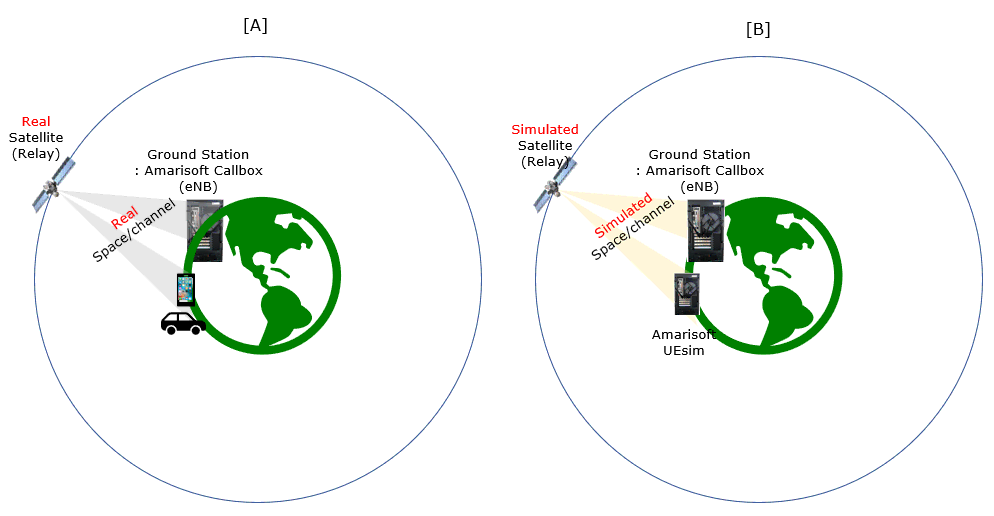
Key Configuration Parameters
Followings are important configuration parameters for this tutorial. You may click on the items for the descriptions from Amarisoft documents.
- ntn : In this link, you can find the descriptions for all the parameters below.
- ephemeris
- use_state_vectors
- eci_reference
- ground_position
- n_ta_common
- n_ta_drift
- n_ta_drift_var
- n_ta_common_offset
- feeder_doppler_compensation
- feeder_dl_freq
- feeder_ul_freq
- large_freq_shift
- direct_to_cell
- channel_sim_control
- type
- ue_position
- ue_doppler_shift
- ue_dl_freq
- ue_ul_freq
- feeder_doppler_shift
- ue_dl_attenuation
- ue_dl_gain_offset
- ul_sync_validity
- k_offset
- k_mac
- dynamic_k_offset
- reference_location
- t_service
- neighbour_cells
- rat_type
- t318
Before You Start : Time Synchronization
In NTN (Non-Terrestrial Networks), time synchronization across all communicating entities (satellite, gNB, UE, gateways, and sometimes multiple satellites) is fundamental, not just an implementation detail. This is because time directly maps to distance, frequency, and geometry in NTN.
There are multiple layers of technology required to achieve timing synchronization in NTN systems. These layers span from fine-grained timing, such as GNSS-disciplined clocks, PTP (IEEE 1588), and PHY-level frame alignment, to relatively coarse-grained synchronization, such as system clock alignment across hosts.
Each layer serves a different purpose. Fine-grained timing is mandatory for air-interface operation, including OFDM symbol alignment, timing advance, and Doppler compensation. Coarse-grained timing is mainly used to keep different system components operating on a consistent time reference.
In this section, I focus on one of the base minimum requirements: timing synchronization via NTP. NTP may not be sufficient for NTN PHY operation, but it is still an important prerequisite at the system level. This becomes especially important when testing NTN using Amarisoft Callbox and UE-sim. In such setups, the gNB, UE-sim, channel models, and supporting software often run on separate hosts or containers. If their system clocks are not aligned at least at the NTP level, issues such as inconsistent logs, invalid timing assumptions, and misleading test results can occur.
Enable NTP Client on Fedora Linux (Chrony)
This tutorial explains how to enable and verify NTP time synchronization (client mode) on a Fedora system using chrony, which is the default NTP implementation on Fedora. (
Prerequisites
- Fedora Linux
- User with sudo privileges
- Internet or access to an NTP server
Step 1: Install Chrony
Chrony is usually installed by default, but you can ensure it is present:
|
sudo dnf install -y chrony |
Step 2: Enable and Start the Chrony Service
Enable chrony to start at boot and start it immediately:
|
sudo systemctl enable --now chronyd |
Verify the service status:
|
systemctl status chronyd |
You should see the service running (active).
Step 3: Enable NTP via timedatectl
Fedora uses timedatectl to manage system time synchronization.
Enable NTP:
|
sudo timedatectl set-ntp true |
Verify:
|
timedatectl status |
Expected output fields:
|
System clock synchronized: yes NTP service: active |
Step 4 (Optional): Configure Custom NTP Servers
Edit the chrony configuration file:
|
sudo nano /etc/chrony.conf |
Add or modify NTP servers, for example:
|
server 0.pool.ntp.org iburst server 1.pool.ntp.org iburst server time.google.com iburst |
Save the file and restart chrony:
|
sudo systemctl restart chronyd |
Step 5: Verify Time Synchronization
Check synchronization status:
|
chronyc tracking |
View NTP sources:
|
chronyc sources -v |
A reachable source marked with ^* indicates active synchronization.
Step 6 (Optional): Force Immediate Time Sync
If the system clock is significantly incorrect:
|
sudo chronyc makestep |
Troubleshooting
Check chrony service:
|
systemctl status chronyd |
Check logs:
|
journalctl -u chronyd |
Firewall (normally not required for client mode):
|
sudo firewall-cmd --list-all |
Summary
|
sudo dnf install -y chrony sudo systemctl enable --now chronyd sudo timedatectl set-ntp true chronyc tracking |
Your Fedora system is now configured as an NTP client and will keep accurate time automatically.
Test 1 : NTN with Simulated GEO and UEsim
This is to configure and test NTN for Simulated GEO using Amarisoft UEsim as DUT.
Configuration
The configuration shown here is common configuration for all the subtests belonging to Test 1 and I will not show this configuration repeatedly for every subtest.
I have used gnb-sa-ntn.cfg which is included in the default installation package on Callbox (gNB)

I am using mme-ims.cfg and ue_db-ims.cfg as they are.
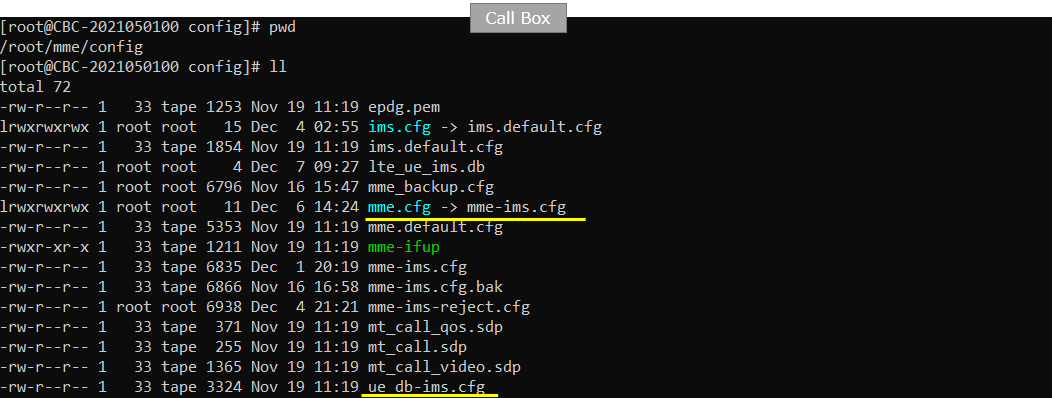
On UEsim, I used ue-nr-ntn.cfg which is included in the default installation package on UEsim (

gnb-sa-ntn.cfg is configured as follows.
In gNB configruation, specify satellite orbit first with the test parameter NTN_MODE. You can select the type among GEO, MEO, LEO. In this test, GEO is selected. Once this parameter (NTN_MODE) is specified, various other test parameters are configured based on the selected NTN_MODE. CSI_SRS_PERIOD, MAX_HARQ, T3XX_TIMER, SRB_T_POLL_RETX are the parameters configured differently based on NTN_MODE. And CHANNEL_SIM is enabled to simulate the radio link between the ground station and satellite.
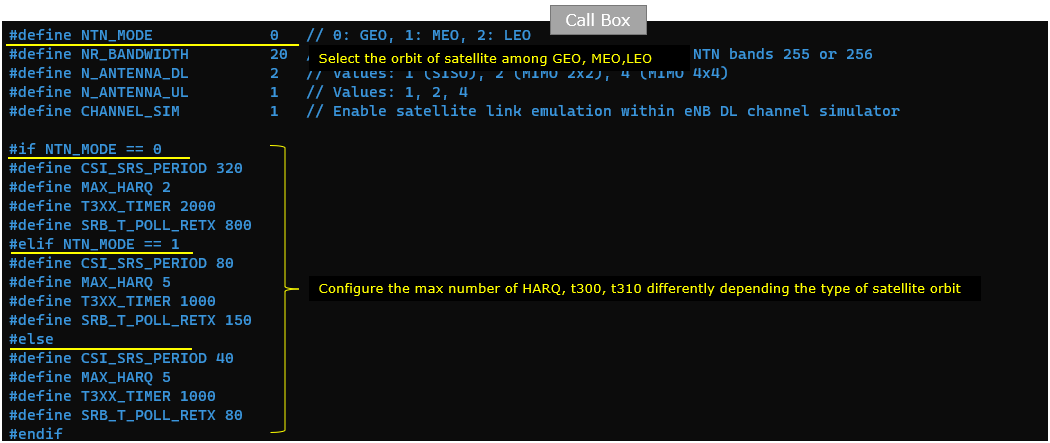
If CHANNEL_SIM is enabled, you can apply various channel profile to simulate the radio link between ground station and satellite. In this test, only awgn is applied.

SSB periodicity is adjusted based on orbit type. In this test (with GEO), ssb_period is set to 20.

Then enable sib19 which is to broadcast NTN related information.

Now as MAC configuration, configure retx_bsr_timer, sr_prohibit_timer, prohibit_phr_timer, sr_trans_max differently based on the type of orbit. The basic idea is to configure these parameters differently based on RTT between the satellite and ground station.
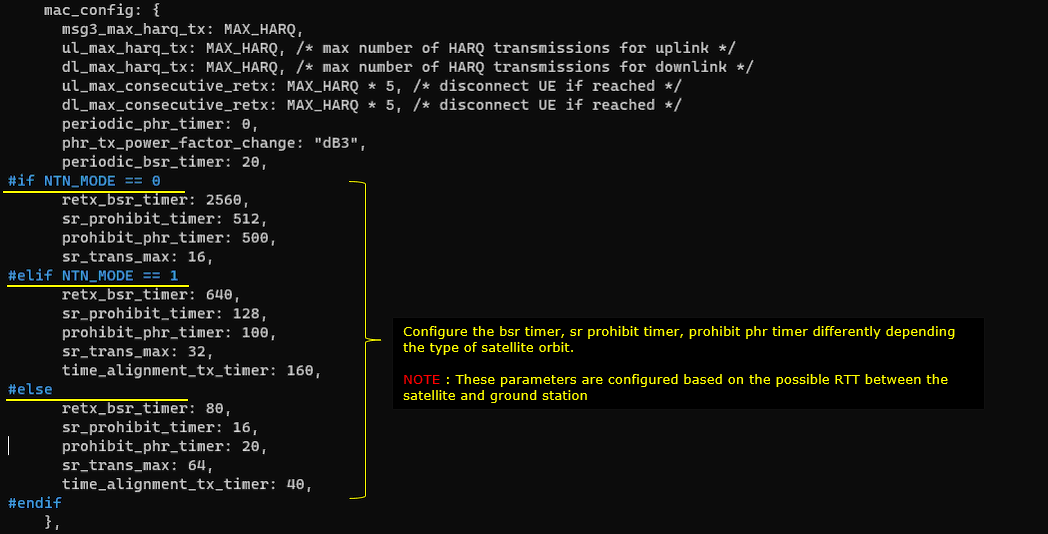
Then adjust RRC timers t300, t301, t319 appropriately for each orbit type. And then adjust t_PollRetransmit based on the type of the orbit.

Now for the configurations specific for ntn. The configuration parameter name itself is ntn. In this parameter, you can specify the location of the satellite (i.e, the ephemeris), the location of ground station (i.e, the location of gNB) and ue location. The location of the ground station is specified by the parameter ground_position, the location of UE is specified by the parameter ue_position and the position of the satellite is specified by the parameter default_ephemeris.
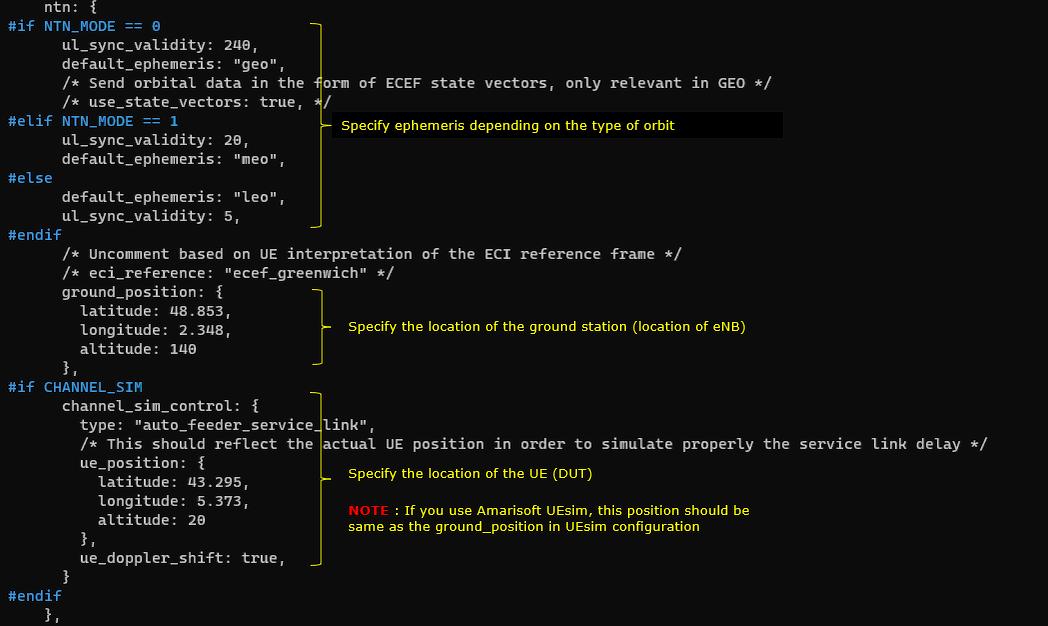
ue-nr-ntn.cfg is configured as shown below. (
In UEsim configuration, you need to enable ntn functionality first by setting ntn:true and then configure the position of the UEsim. The position of UEsim is configured by the parameter ntn_ground_position and the ntn_ground_position on UEsim should match ue_position in gNB settings.
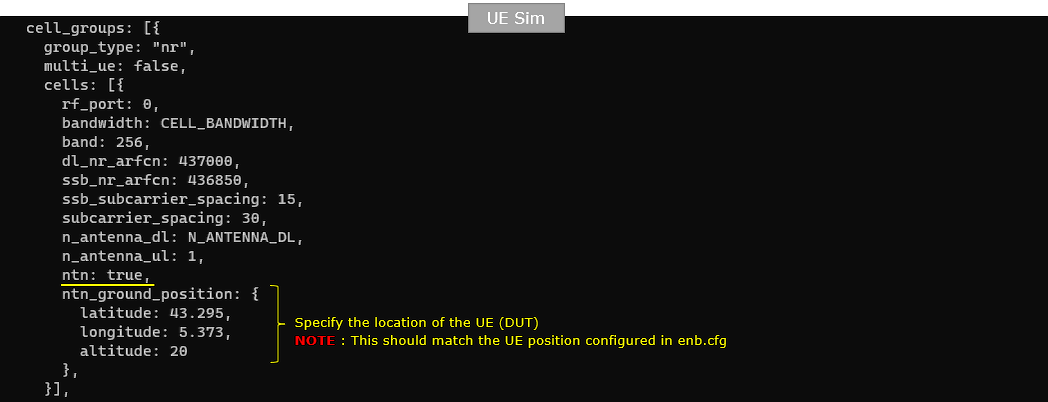
Then you need to set as_release 17 since NTN is supported from release 17 and specify the apn name that you want to use for this test. (

Perform the Test
Run lte service on callbox and then check 'cell phy' and 'cell' command. Make it sure that cell is configured as you intended. In this test, n256 is used because it is the band allocated for NTN by 3GPP, but in terms of the equipment capability it can support any band for NTN test.

This is not the mandatory process.. but I did this to collect SIB message in the log for a few seconds at the beginning. I did bcch=1 and after a few seconds did bcch=0.
![]()
Now start trace logging.
![]()
Power on UE on UEsim (If your DUT is a commercial phone, turn on the phone)

Wait until the DUT complete the initial attach. (

Log Analysis
Following is the log snapshot that are involved in communication with NTN.
First check SIB1 and see if the timers are configured as you intended and the cell is properly broadcasting about NTN supportability. The timers you need to check is t300,t301 and t319 in ue-TimersAndConstraints and the NTN supportability can be checked by the IE cellBarredNTN.
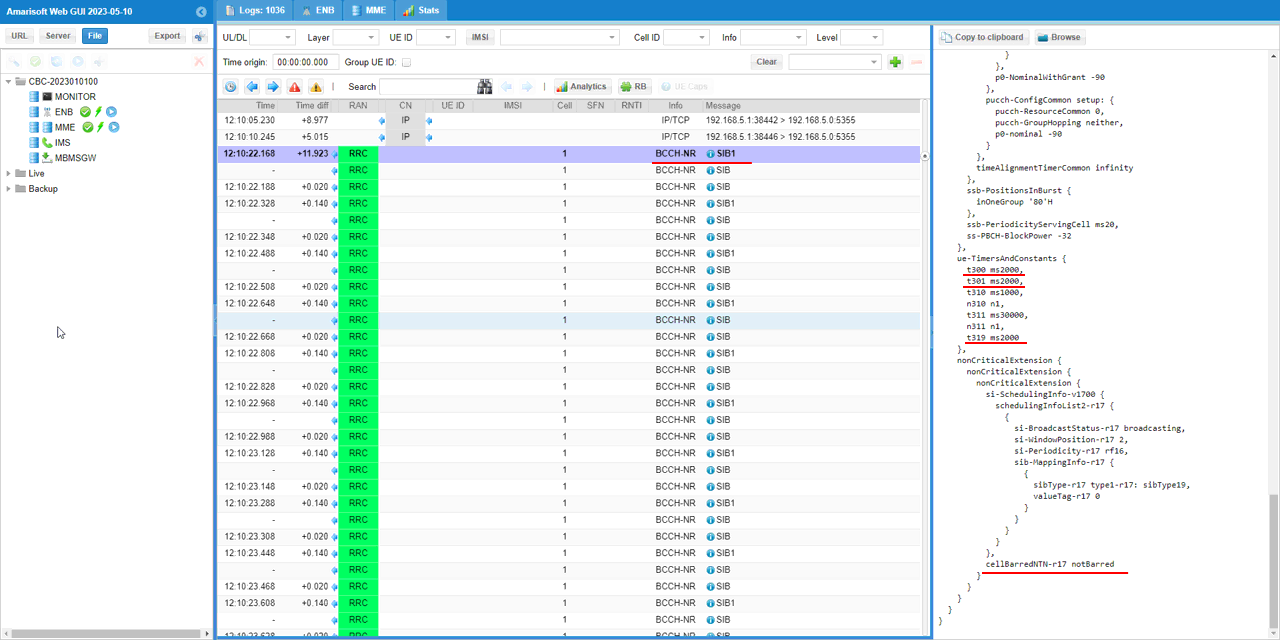
Now check if SIB19 is transmitted and ntn-Config IE is populated as you intended. The important information in this SIB is ta-Common and ephemrisInfo.
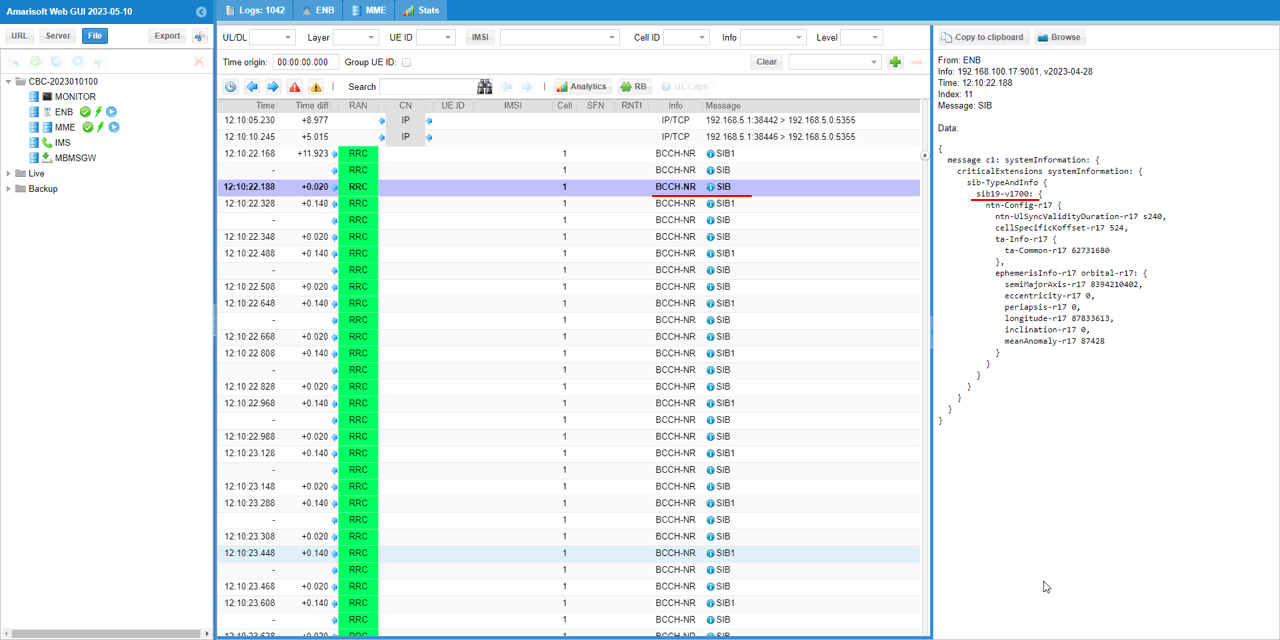
With powering on UE and UE is doing the initial attach, check UE capability information and make it sure that the UE support ntn. If the UE capability information message contains the IE ntn-Parameters, it mean the UE support NTN.
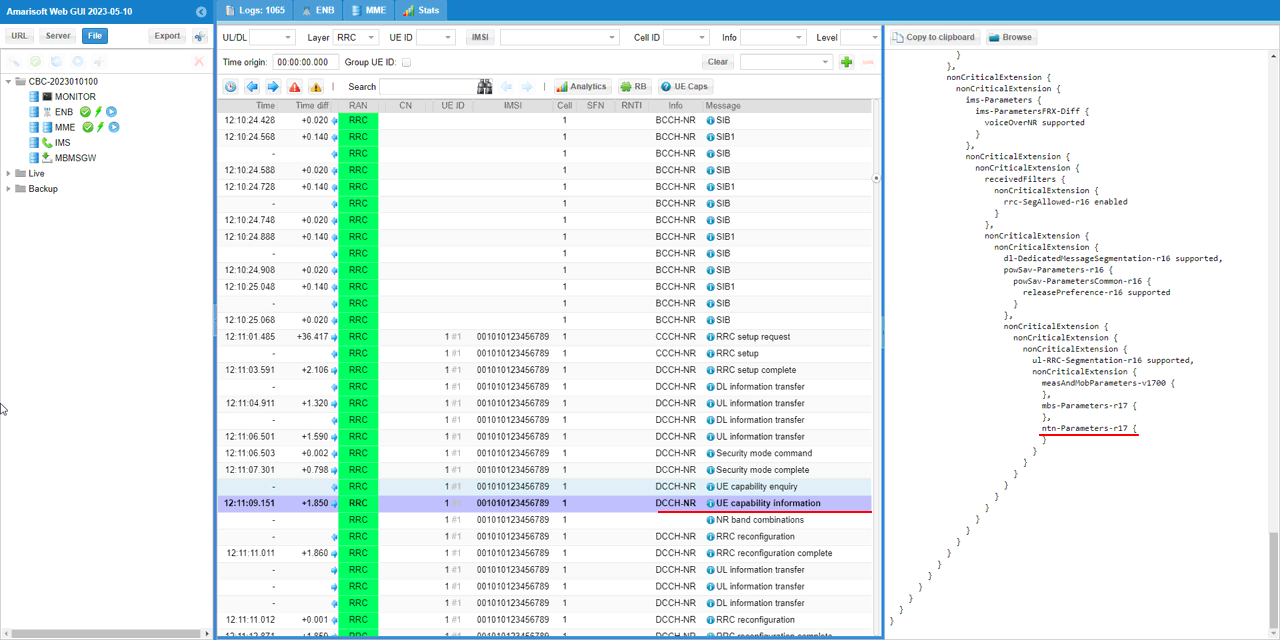
At the lower layer log, confirm that RACH process went through. (
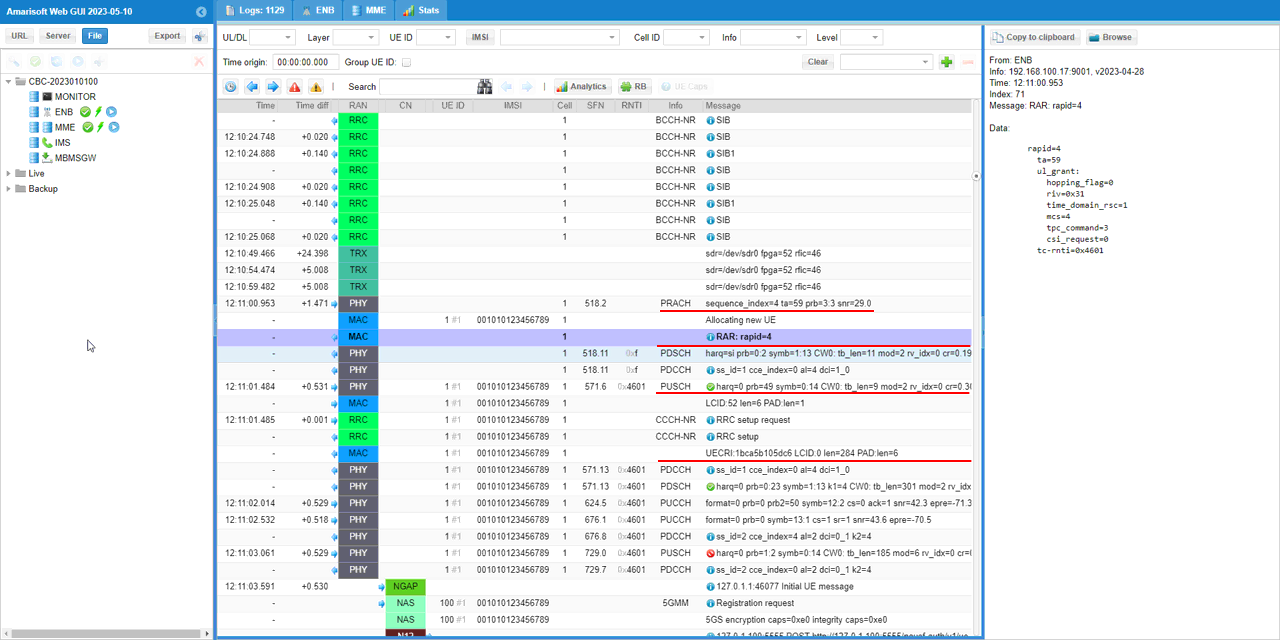
After the connection is established, gNB would re adjust timing advance periodically to maintain the connection by sending Timing Advance MAC CE.
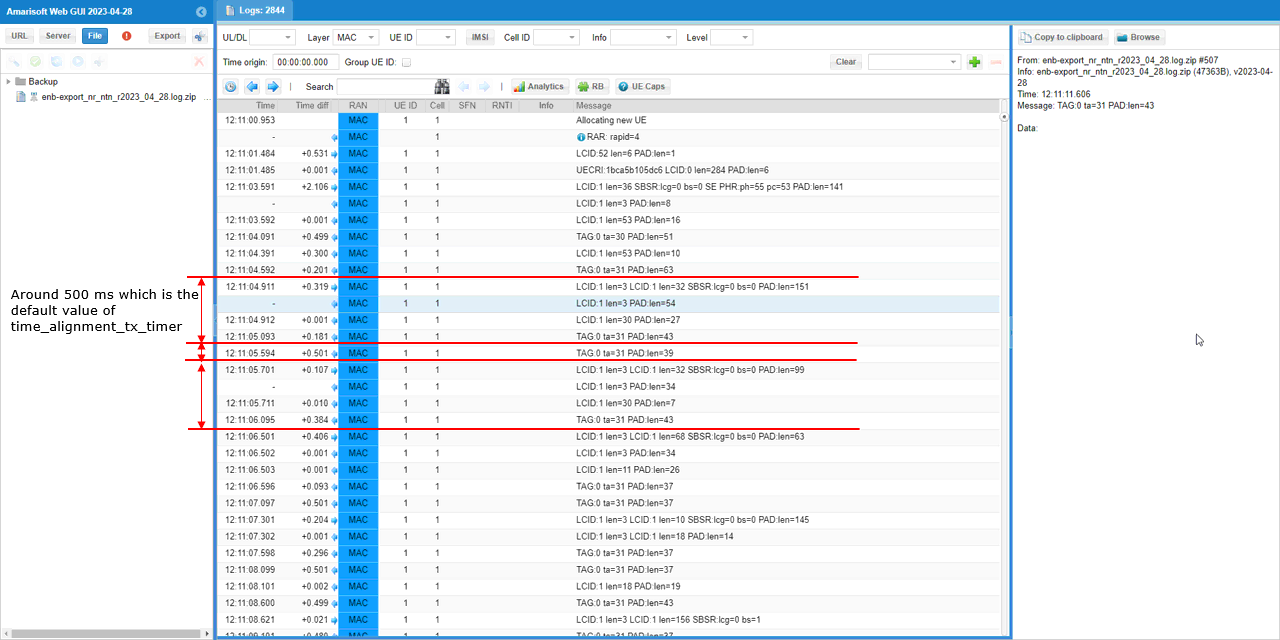
Test 2 : NTN with LEO
This part is intended as a troubleshooting guide for all the issues you can encounter when testing LEO (Low Earth Orbit). Most of the difficulties come from the fact that a satellite in low earth orbit will move very quickly relative to the surface of the earth.
With generated satellite and embedded simulator
Performing a test with Amarisoft embedded channel simulator will remove most of the difficulties. You can use the standard configuration gnb-sa-ntn.cfg and set the macro NTN_MODE to 2.
At startup, the eNB will generate a satellite directly over the eNB position, and rapidly moving to the east from there on. You will have around 5 minutes during which the simulated satellite is visible to perform the test.
You can adjust the default_elevation_offset parameter to instantiate the satellite before or after its zenith pass if you want to experiment with a longer test duration or on the opposite to quickly simulate the behaviour when the satellite goes beyond visibility
On the UE side, the most important thing to check is that
Of course, as with GEO testing, the UE position also needs to match the position specified by the parameter ue_position of the gNB NTN channel simulator
With a 3rd party external simulator or a real satellite
Most issues will arise when testing with an external channel simulator, here are the most obvious ones, and how to mitigate them
Clock synchronization
With an external channel simulator, you have now three devices that need to be perfectly in sync: The gNB, the channel simulator and the UE.
You will also use ephemeris from a real satellite with a TLE file, instead of the 'default_ephemeris' so there will be only a few passes per day, on precise timing : This is not convenient for testing.
So, you need to have the ability to
One solution is to set one component of the system, eg the channel simulator, as an NTP server. And setup NTP client on eNB and UE side to fetch the date and time from the channel simulator.
Timing and frequency errors
Errors between the calculation performed on eNB side, UE side and channel simulator will in the end gives some errors on the eNB UL side: The timing and frequency of the UL signal received from the UE will be off.
The main causes for these errors will be :- Clock synchronization issues, see above
- Difference in satellite propagation model between eNB/UE and 3rd party channel simulator. To have better result, it is important to use a recent TLE file (less than a day), especially if the orbit altitude is low.
- There can be a lot of frequency translation units if the satellite links are over Ka/Ku band and each of these can add a frequency error. When using high frequency links, a small ppm error gives a rather larger frequency error in Hz
By carefully configuring the setup, these errors can be minimized but the eNB still needs to be robust to unforeseen errors.
Concerning the timing robustness, it is best to use PRACH format 1 (prach_configuration_index from 28 to 52), which has the biggest cyclic prefix. Since the timing inaccurracy can occur in both directions, it is advised to set rx_ta_offset in the middle of the PRACH reception window.
Concerning the UL frequency robustness, the problem is that NR (and OFDM protocol in general) are very sensitive to frequency error, and there is no builtin mechanism in the NR protocol to signal the UE of a frequency error.
So the eNB needs to rely on an ad-hoc solution to estimate the frequency error based on signal received from the UE and correct them. Note that this solution will only work if all the UE<->eNB links will share the same kind of frequency errors.
The large_freq_shift configuration object is used to estimate the frequency error seen on the PRACH signals. The gNB will perform some measurements on the first PRACH (and discard them) before applying a frequency correction and resuming normal PRACH operations.
Putting it all together
Here are the relevant parameters of the configuration file that need to be present and/or tuned depending on how the integration is going :
rx_ta_offset: 650, // Middle of the timing reception window of the PRACH
[...]
nr_cell_list: [
{
[...]
root_sequence_index: 12, // This root sequence index give consistent results when signal frequency is off
compute_freq_shift: true, // Necessary for the large_freq_shift feature
prach: {
prach_config_index: 40, // PRACH format 1, once every 2 frames
zero_correlation_zone_config: 0, // Maximum timing error tolerance
ra_response_window: 10,
ssb_per_prach_occasion: 1,
cb_preambles_per_ssb: 8,
[...]
},
[...]
ntn: {
large_freq_shift: {
prach_range_sc: 128, // Maximum frequency error correction in PRACH SCS unit. (Here 128*1.25KHz = 160 kHz)
prach_n_acc: 5, // Number of PRACH to accumulate before estimating the frequency offset
ta_tolerance: 8, // TA range below which PRACH are considered coming from the same UE
average_mode: true, // Averaging strategy to determine the frequency error based on the prach_n_acc PRACHs : average or mode
},
[...]
}
Test 3 : NTN to TN Handover
This is to configure and test Handover from NTN to TN cell using Amarisoft UEsim as DUT. Overall scenario is illustrated as below. The UE (UEsim) establish the initial attach to NTN cell and switch (Handover) to TN Cell (i.e, gNB cell on the ground) as the satellite moves away from NTN gNB.
Configuration
The configuration shown here is common configuration for all the subtests belonging to Test 1 and I will not show this configuration repeatedly for every subtest.
I have used gnb-sa-tn-ntn-ho.cfg which is included in the default installation package on Callbox (gNB)
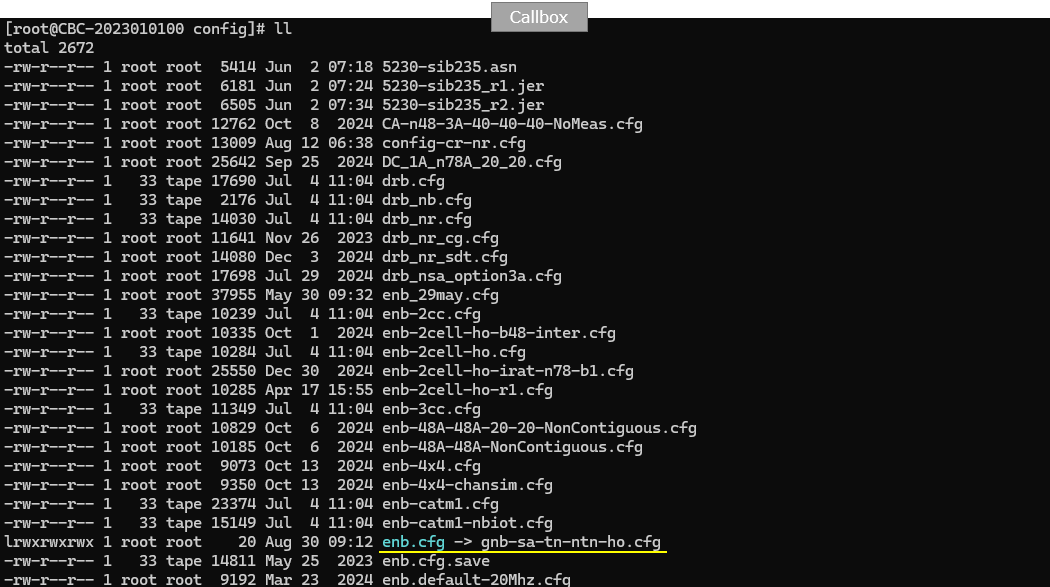
I am using mme-ims.cfg and ue_db-ims.cfg as they are.

On UEsim, I used ue-nr-tn-ntn-ho.cfg which is included in the default installation package on UEsim (
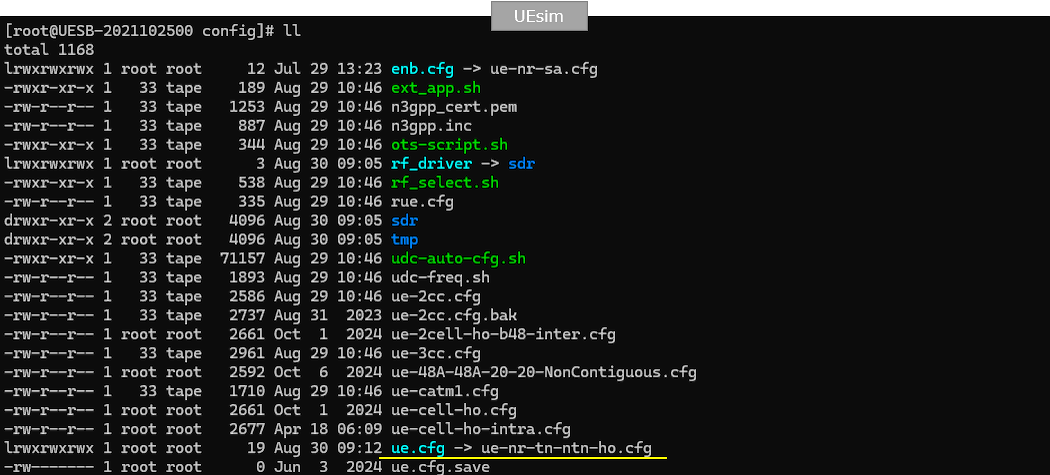
gnb-sa-tn-ntn-ho.cfg is configured as follows.
In gNB configruation, specify satellite orbit first with the test parameter NTN_MODE. You can select the type among GEO, MEO, LEO. In this test, GEO is selected. Once this parameter (NTN_MODE) is specified, various other test parameters are configured based on the selected NTN_MODE. CSI_SRS_PERIOD, MAX_HARQ, T3XX_TIMER, SRB_T_POLL_RETX are the parameters configured differently based on NTN_MODE. And CHANNEL_SIM is enabled to simulate the radio link between the ground station and satellite.
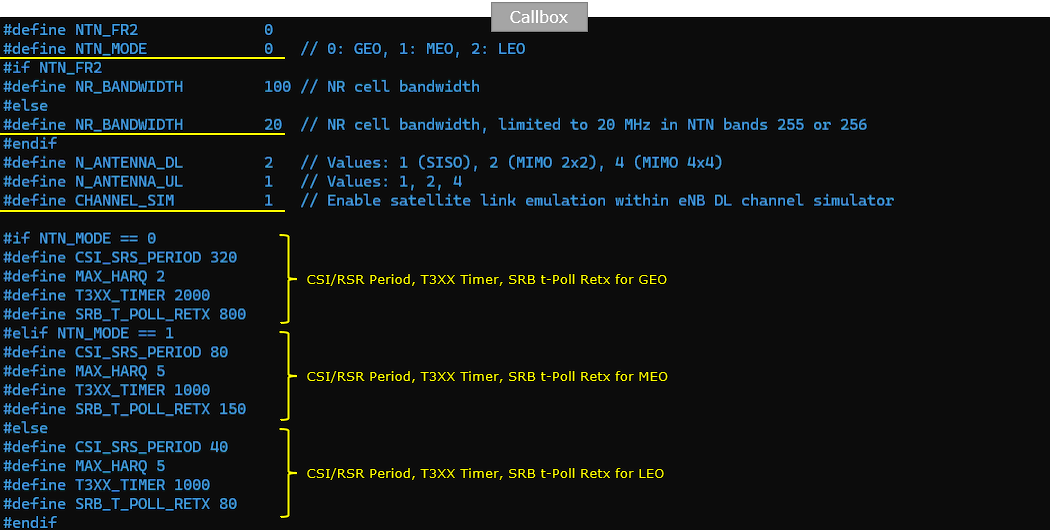
If CHANNEL_SIM is enabled, you can apply various channel profile to simulate the radio link between ground station and satellite. In this test, only awgn is applied.

The first cell (the cell mapped to rf_port 0) is configured for ntn cell. NTN mode is set to GEO in this test and SIB19 is transmitted to broadcast ephemeris information of the cell. In this cell, the TN cell (cell_id 2) is configured as a neighbour cell(a handover destination candidates for this test)
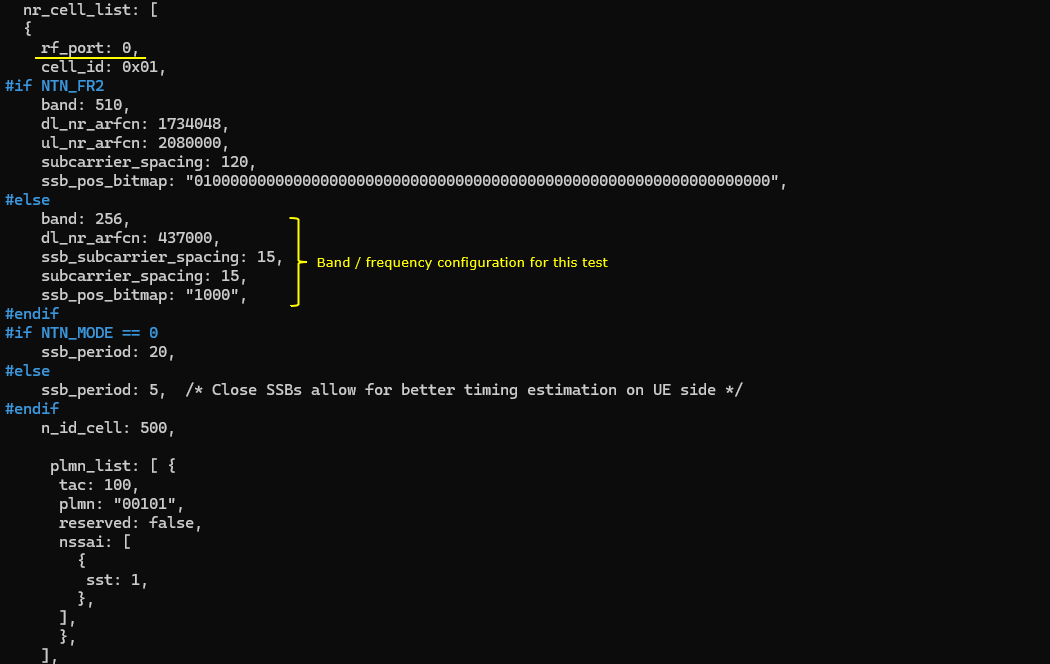

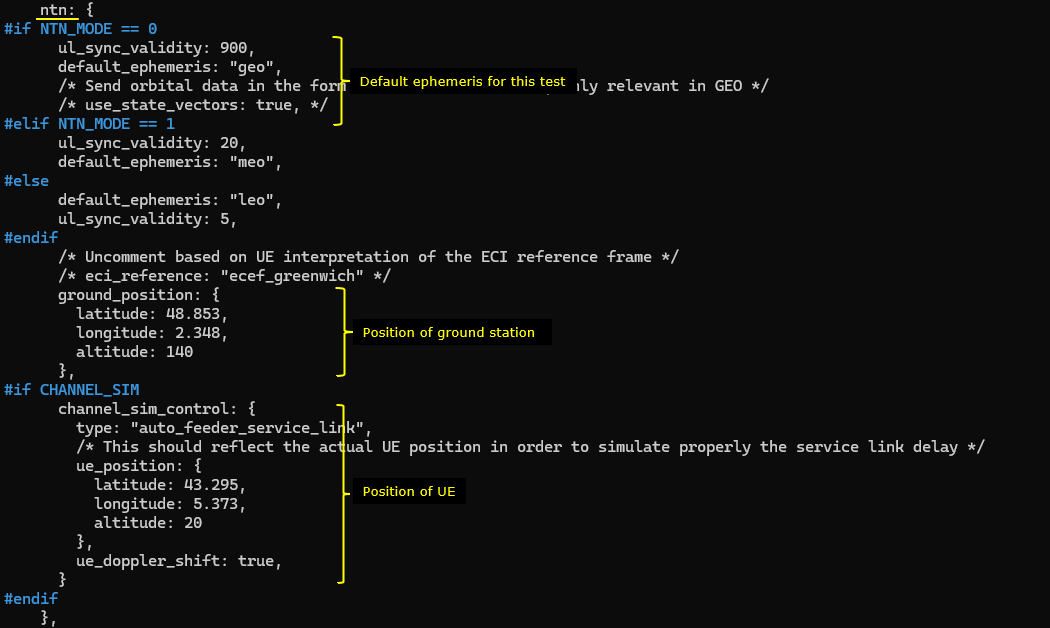

The cell mapped to rf_port1 is configured for the regular NR Cell (TN Cell). In this cell, the NTN cell (cell_id 1) is configured as a neighbour cell(a handover destination candidates for this test)
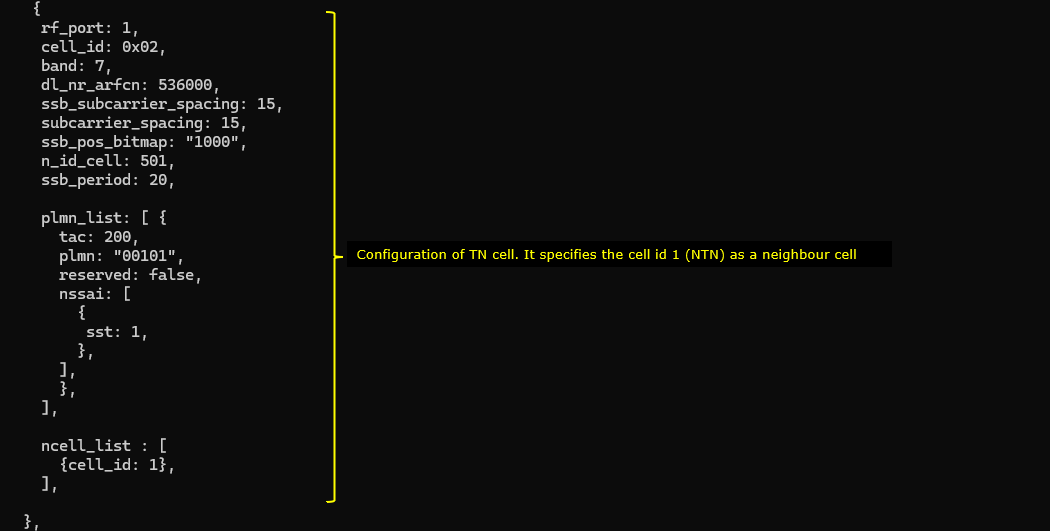
The default cell configuration (nr_cell_dfault) is very similar to regular NR to NR cell configuration except some specific configurations for NTN cell.
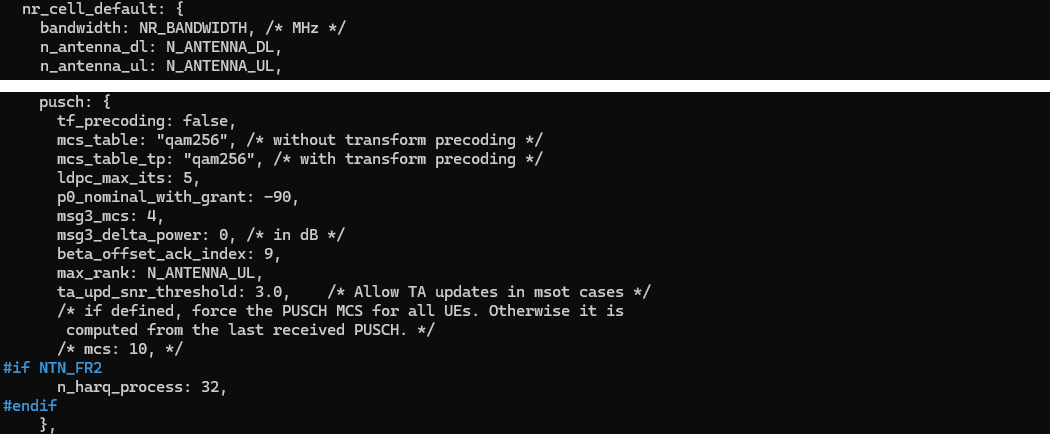
In MAC configuration (mac_config), various harq configurations (msg3_max_harq_tx, ul_max_harq_tx, dl_max_harq_tx) and retransmission configurations (ul_max_consecutive_retx,dl_max_consecutive_retx) are configured to accommodate the propagation dely of the NTN cell. In addition, some mac layer timers (retx_bsr_timer, sr_prohibit_timer, prohibit_phr_timer) are configured differently depending on the orbits of the satellite.
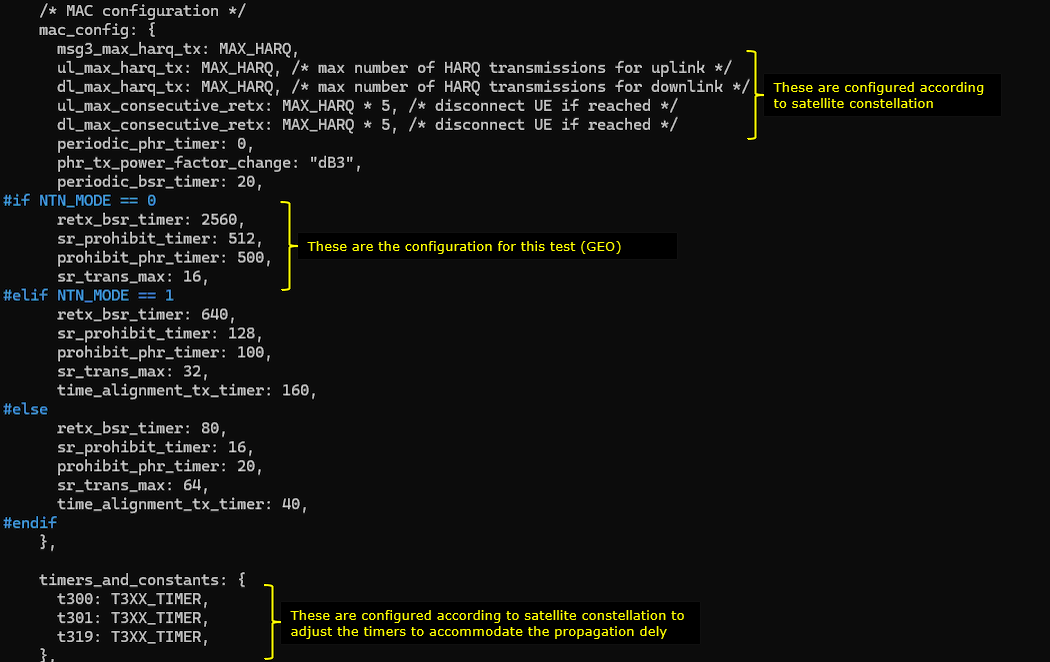
Then measurement configuration (meas_config_desc) should be configured to trigger the handover based on radio channel condition.
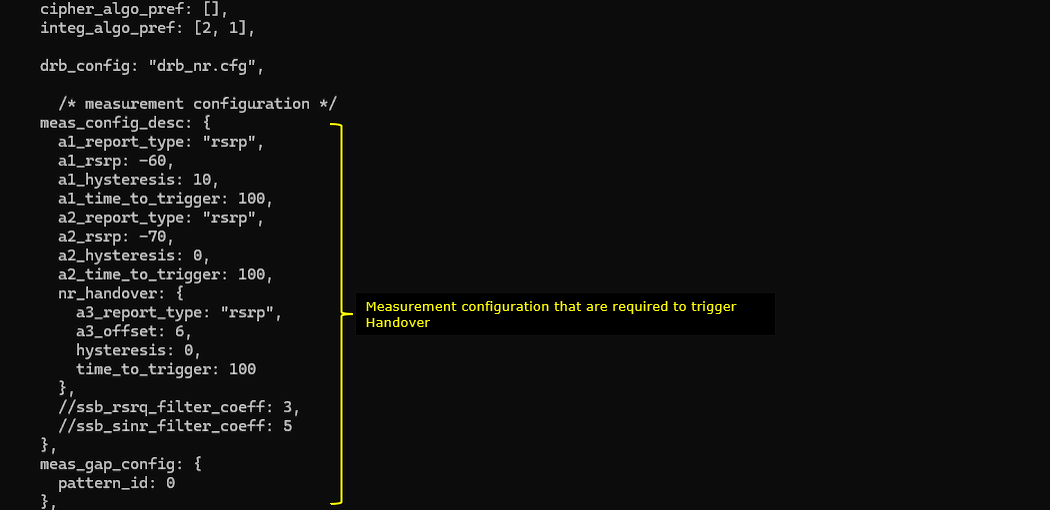
ue-nr-tn-ntn-ho.cfg is configured as shown below. (
In UEsim configuration, you need to enable ntn functionality first by setting ntn:true and then configure the position of the UEsim. The position of UEsim is configured by the parameter ntn_ground_position and the ntn_ground_position on UEsim should match ue_position in gNB settings.

UEsim is configured with two RF chains (rf_port 0 and 1). The first RF chain (rf_port 0) is mapped to NTN Cell and the second RF chain (rf_port 1) is mapped to TN cell.
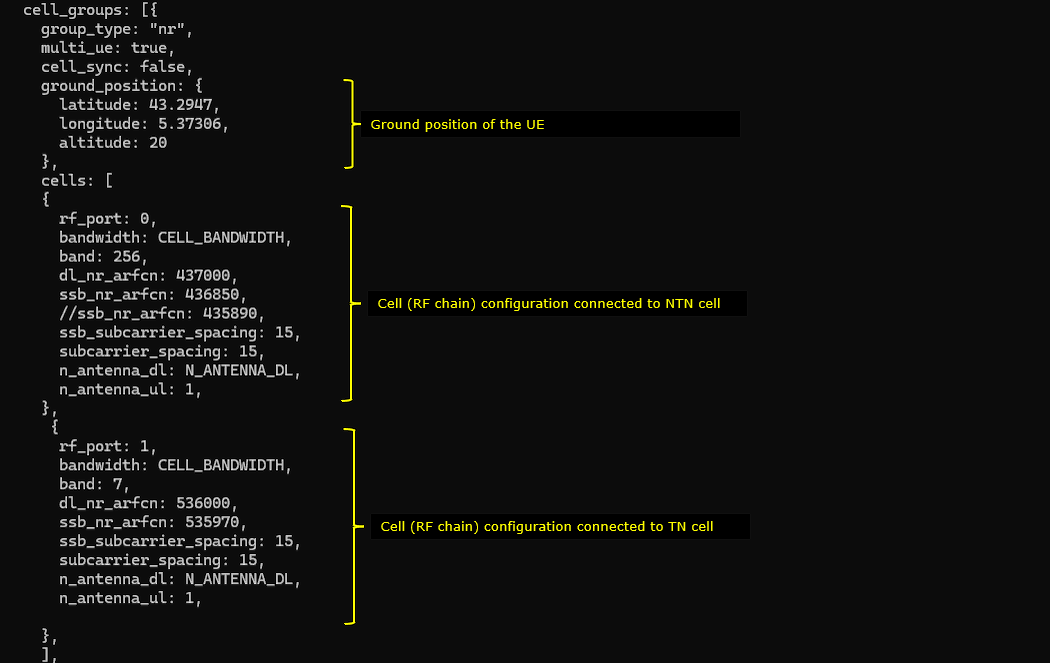
Then you need to set as_release 17 since NTN is supported from release 17 and specify the apn name that you want to use for this test. (

Perform the Test
Run lte service on callbox and then check 'cell phy' and 'cell' command. Make it sure that cell is configured as you intended. In this test, n256 is used because it is the band allocated for NTN by 3GPP, but in terms of the equipment capability it can support any band for NTN test.

This is not the mandatory process.. but I did this to collect SIB message in the log for a few seconds at the beginning. I did bcch=1 and after a few seconds did bcch=0.
![]()
Now start trace logging.
![]()
Power on UE on UEsim (If your DUT is a commercial phone, turn on the phone)

Wait until the DUT complete the initial attach. (

Once UEsim is in connection with NTN cell, reduce the cell power to trigger the handover (

Log Analysis
Following is the log snapshot that are involved in communication with NTN and Handover to TN cell.
First thing to note is measurement configurations to detect appropriate channel condition to complete the handover.
RRC Reconfiguration message configures two measurement objects. It configures two measurement object - measObjectId 1 for an NTN cell (measObjectNR) with frequency 436580 (ssbFrequency) and measObjectId 2 for a terrestrial TN cell (measObjectNR) with frequency 359700 (ssbFrequency). Each object includes SSB subcarrier spacing (ssbSubcarrierSpacing), periodicity/offset (periodicityAndOffset), reference signal config (referenceSignalConfig), and frequency band indicators (freqBandIndicatorNR).
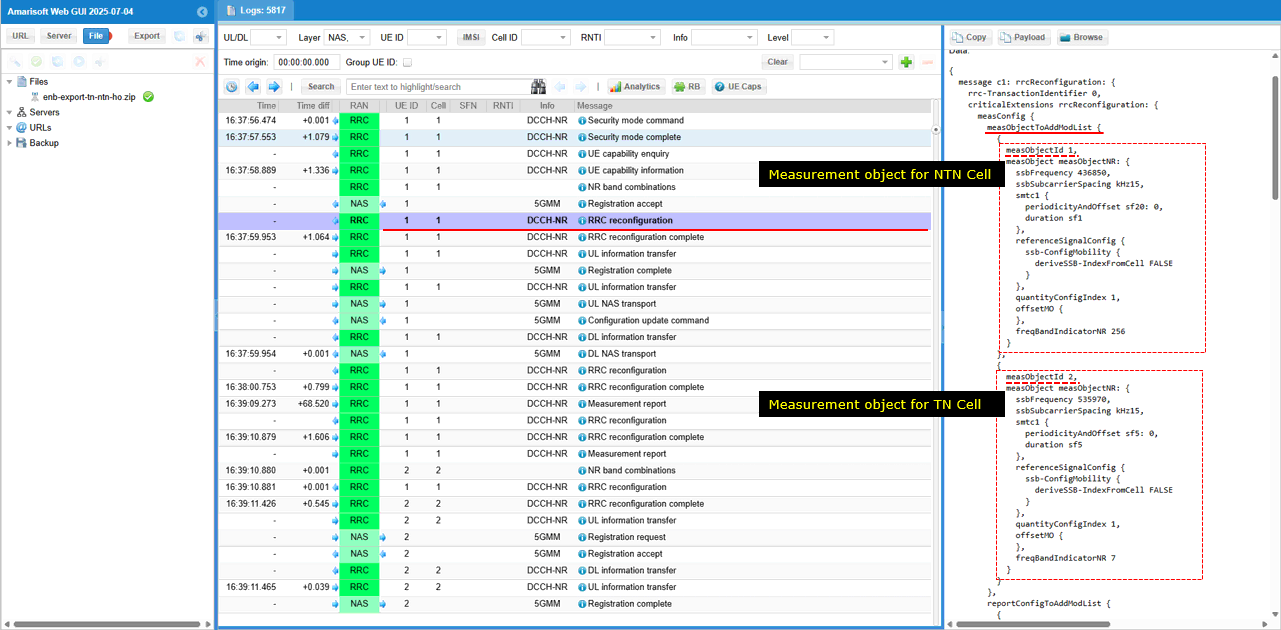
It configures two measurement report objects (reportConfigToAddModList) - reportConfigId 1 for Event A2 (eventTriggered → eventId: eventA2), including threshold RSRP (a2-Threshold-rsrp), hysteresis (hysteresis), report interval (reportInterval), and report quantity (reportQuantityCell). It also lists reportConfigId 2 for Event A3 (eventTriggered → eventId: eventA3), including offset RSRP (a3-Offset-rsrp), report interval (reportInterval), report amount (reportAmount), and reporting cells (maxReportCells).
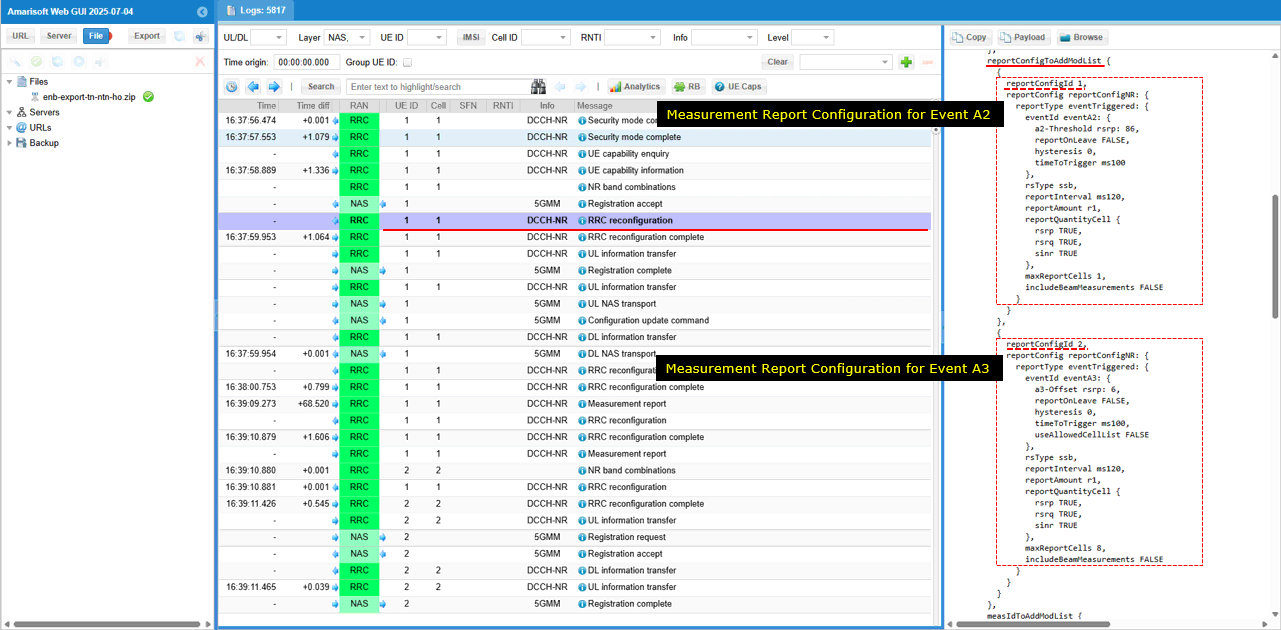
The same message configures the association between a measurement object and a reporting event. In the section measIdToAddModList, entry measId 1 links measurement object 1 (measObjectId 1, corresponding to the NTN cell) with report configuration 1 (reportConfigId 1, corresponding to Event A2). This enables measurement of the NTN cell under the Event A2 reporting condition.
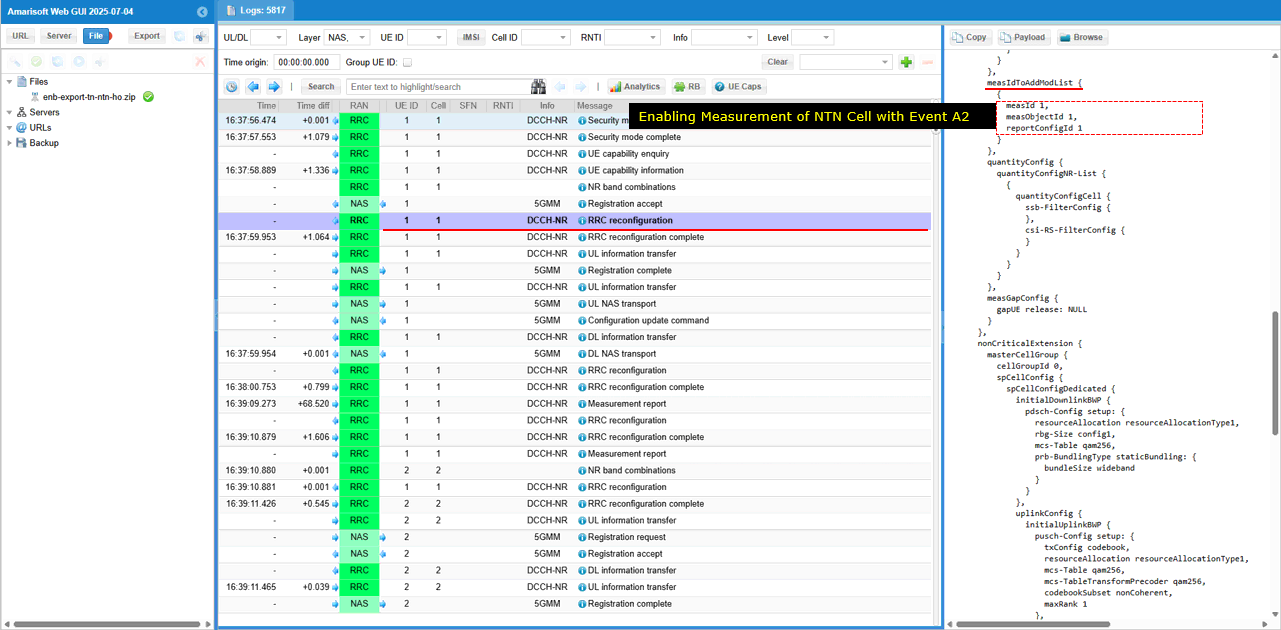
When the condition is met, gNB configures another measurement item : entry measId 2 which links measurement object 2 (measObjectId 2, corresponding to the TN cell) with report configuration 2 (reportConfigId 2, corresponding to Event A3). This enables measurement of the TN cell under the Event A3 reporting condition.
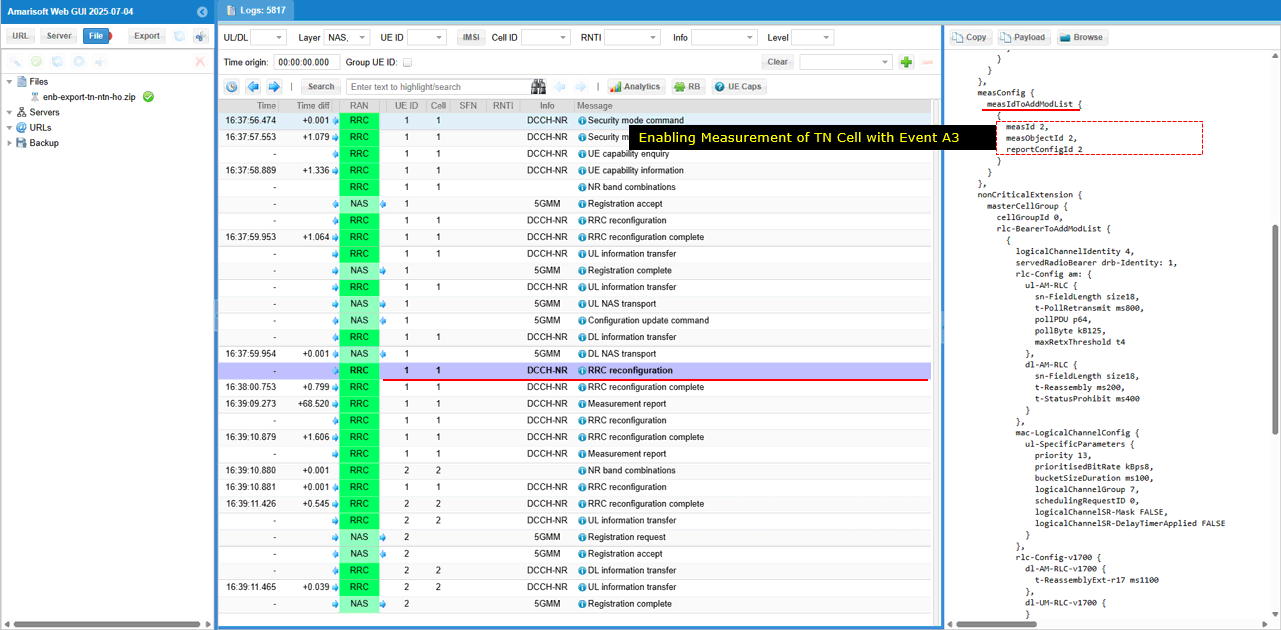
A Measurement Report (measurementReport) sent by the UE after Event A2 was triggered. The report contains the field measResults contains measId 1 (linked to Event A2), and measResultServingMOList includes serving cell results. Within it, measResultServingCell reports PCI (physCellId 500) with measurement values of rsrp, rsrq, and sinr.
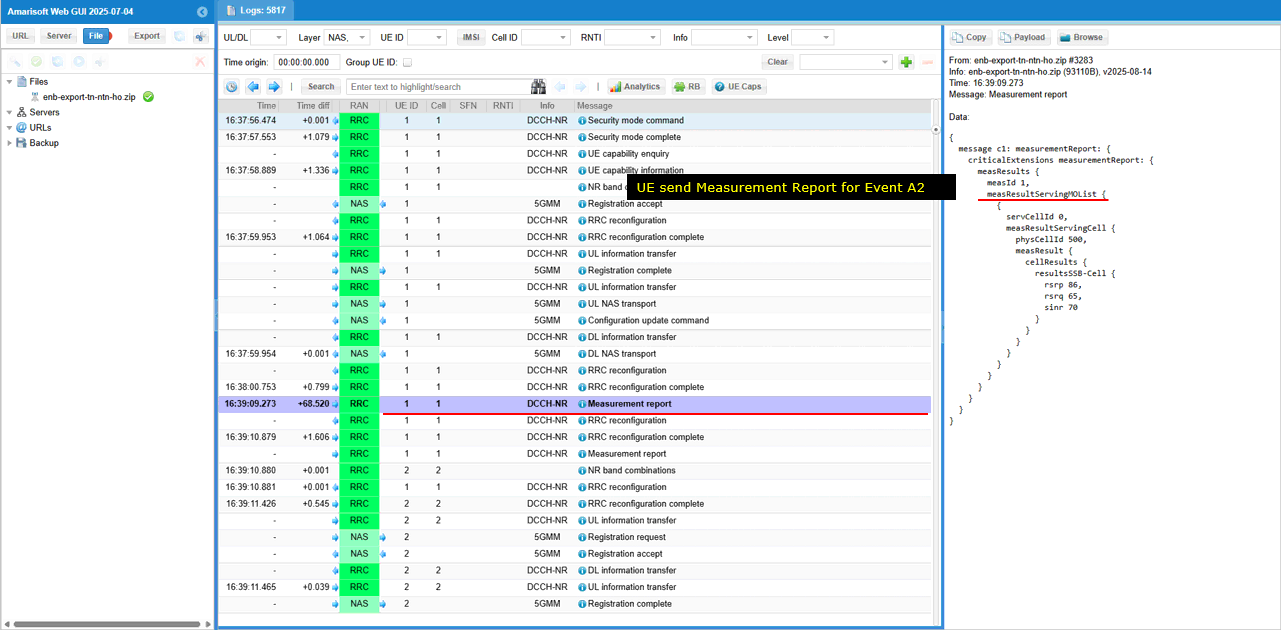
After the first expected measurement report, gNB send RRC Reconfiguration (rrcReconfiguration) that configures both a new reporting event and a measurement gap. In reportConfigToAddModList, reportConfigId 1 is defined for Event A1 (eventId: eventA1) with threshold RSRP (a1-Threshold-rsrp), hysteresis (hysteresis), reporting interval (reportInterval), and report quantity (reportQuantityCell). Below, in measGapConfig, the field gapUE with setup specifies measurement gaps, including gapOffset 16, mgta ms8, and related parameters, enabling the UE to perform inter-frequency/inter-RAT measurements.
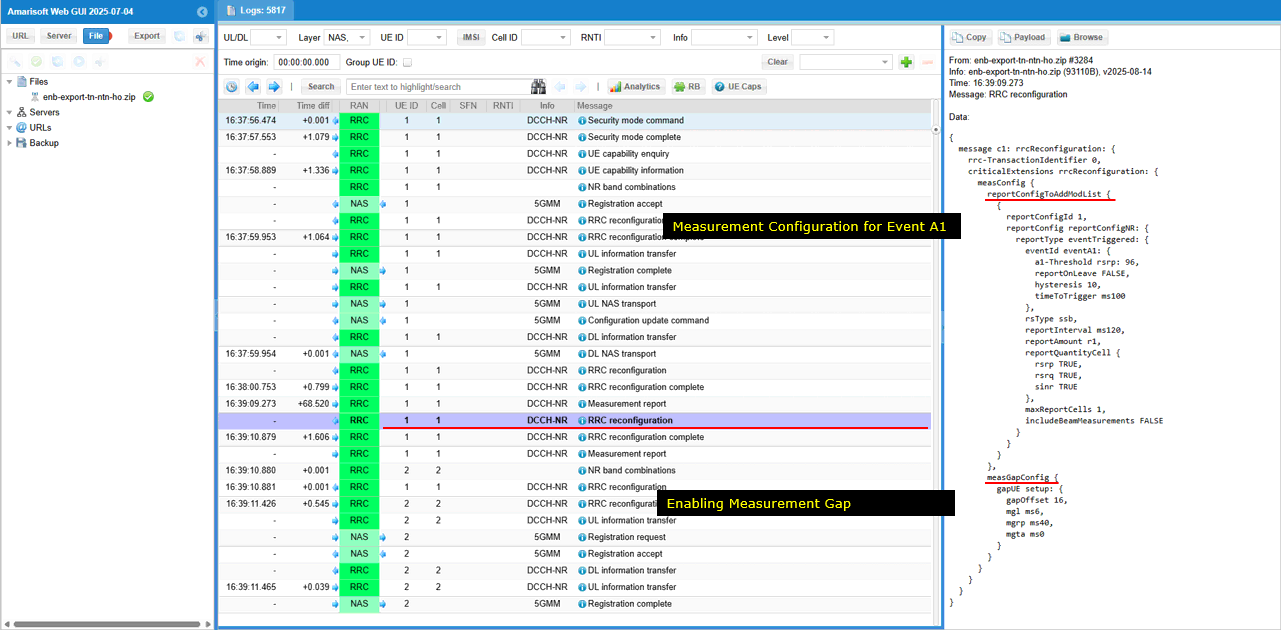
When the certain radio condition is met, the UE send Measurement Report (measurementReport) for Event A3. In the measurement report, measResults contains measId 2 (linked to Event A3). The field measResultServingMOList reports serving cell results (servCellId 0, physCellId 500) with measurements value of rsrp, rsrq, sinr. Additionally, measResultNeighCells (measResultListNR) reports a neighboring cell (physCellId 501) with values of rsrp, rsrq, sinr. This indicates the UE is evaluating handover conditions by comparing serving and neighbor cell quality.
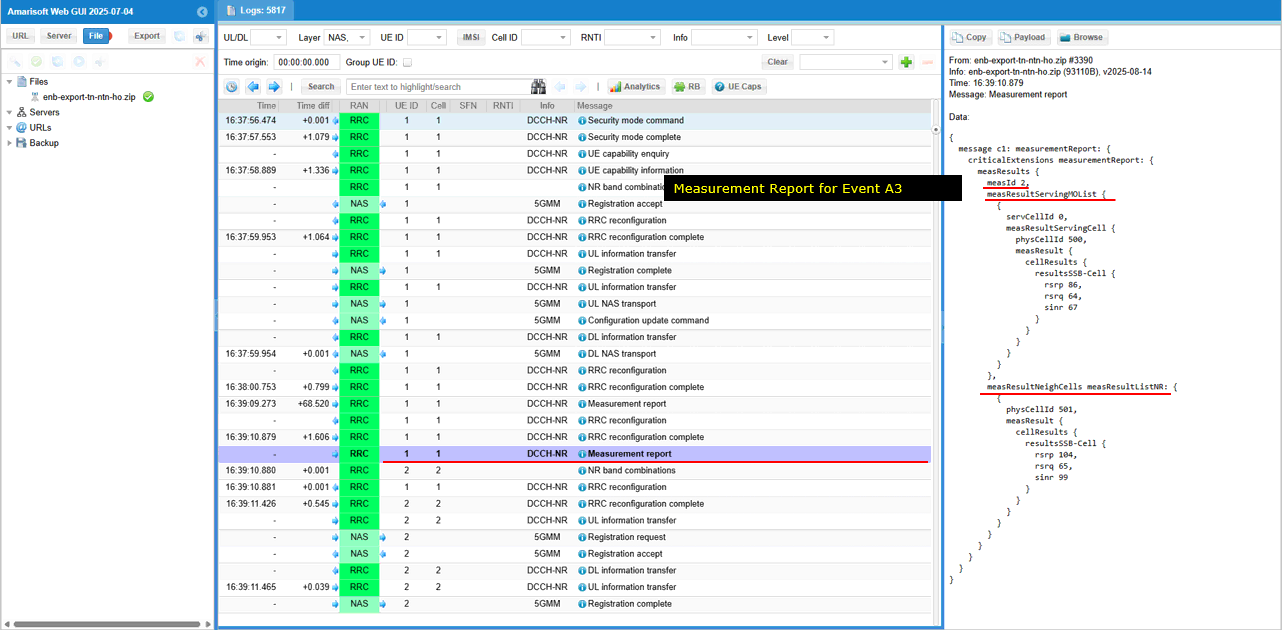
On the reception of the expected measurement report, gNB sends RRC Reconfiguration (rrcReconfiguration) that triggers a handover. In the message, the target cell is identified by physCellId 501, which corresponds to the terrestrial TN cell. The configuration includes downlinkConfigCommon with carrier frequency (frequencyInfoDL), absoluteFrequencySSB , subcarrierSpacing , and carrierBandwidth . This indicates the UE is instructed to hand over from its current serving cell(NTN cell) to the new physical cell ID 501 on the TN network.

RRC / NAS Signaling
SIB19 (NR)
: This is SIB19 containing ephemeris
{
message c1: systemInformation: {
criticalExtensions systemInformation: {
sib-TypeAndInfo {
sib19-v1700: {
ntn-Config-r17 {
ntn-UlSyncValidityDuration-r17 s240,
cellSpecificKoffset-r17 520,
ta-Info-r17 {
ta-Common-r17 62210800
},
ephemerisInfo-r17 orbital-r17: {
semiMajorAxis-r17 8394210402,
eccentricity-r17 0,
periapsis-r17 0,
longitude-r17 248299011,
inclination-r17 0,
meanAnomaly-r17 533258
}
}
}
}
}
}
}
FAQ
I am putting a list of frequently asked questions and answers that would help everybody.
[Q1] why we need channel simulator ?
[A1] It is necessary to simulate the constantly changing real time position of the satellite
[Q2] do we always need to use the channel simulator ?
[A2] Yes for MEO or LEO in which delay and doppler varies relatively in large scale. Maybe optional to GEO in which delay and doppler does not vary widely. (NOTE : You may use the internal channel simulator at the testing phase in quick and easy way, but you can also use an external satellite channel simulator as well).
[Q3] What is the maximum delay simulated by Amarisoft Channel Simulator ?
[A3] Up to several seconds. The maximum value will depend on the sample rate, the value is max_delay in s = 2.147e9 / (sample_rate in Hz). In NB-IoT, for example, the sample rate is usually 1.92 MHz, so the max_delay is around 1118 seconds.
[Q4] What is the minimum configurable altitude of a satellite ?
[A4] The 3GPP encoding for the semi-major axis has a minimum of 6500 km, so a minimum of 122(=6500-6378) km altitude, where 6378 is the radius of the earth
[Q5] For ue_position, ground_position, we allow the altitude with the range of -1000m to 20km, what is the reason to allow negative values ?
[A5] It is to configure altitude below sea level. (https://en.wikipedia.org/wiki/List_of_places_on_land_with_elevations_below_sea_level )